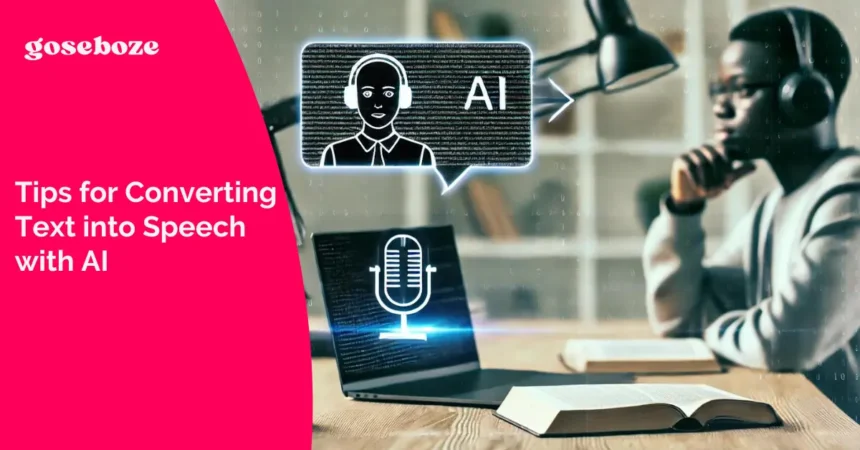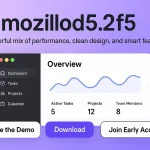Text-to-speech using artificial intelligence has brought about a change in how people consume information through content. If you need to convert text to speech for school, for yourself, or for your company, there are AI solutions available to make it easier.
In this article, you will find out how to make the most of TTS conversion with the help of AI.
Choosing the Right Text-to-Speech Tool
The first thing that needs to be done in order to convert text to speech is choosing the right tool. There are many text to speech services available in the market but not all of them are good in terms of quality, flexibility and user friendly. Some have better and more realistic voices than others and some may include additional features such as choice of accents and voice tone. When selecting the tool, one should think about the requirements of the particular project. If you are going to produce audiobooks or educational materials, the focus on the clarity of the speech and its pronunciation will be critical. In this case, a tool that enables the use of emotional intonation may be more useful for marketing.
In addition, you will need to consider the tools that are compatible with different file formats and languages. Most of the advanced AI-based TTS solutions available in the market today come with multi-language support, which means you can easily translate text to different languages. Moreover, some of the tools enable the user to control the speed and pitch of the voice, which may be useful when targeting particular audiences. Comparing the tools according to the features and ease of use will help in identifying the tool that will meet the set goals.
Customizing the Speech Output
Adapting the speech output is one of the most effective ways of maximizing the use of AI based TTS solutions. The majority of the platforms provide the option of changing the speed, pitch, and tone of the voice. For instance, the speed can be modified in order to achieve a more natural sounding voice while the pitch can be altered to achieve a certain tone. Try these settings to achieve speech that suits the goal of your project, be it a podcast, video, or customer support chatbot.
The second type of customization is the choice of the voice. Most of the AI TTS tools available today come with a number of choices for the voice, including the gender, accent, or even the tone of the voice that is used to read the text. Some of the more sophisticated tools also allow the user to upload sample audio files to clone a specific voice. Adaptation plays a big role in making the speech to sound more natural and more appropriate for the targeted group.
Read Also: How Money FintechZoom is Transforming Financial Management?
Preparing the Text for Conversion
It is therefore important to note that the quality of synthesized speech is highly dependent on the quality of the text input. Properly written text that has no grammatical mistakes and is punctuated properly will result in clearer and more accurate speech. Punctuation is used by the AI tools to know where to pause and this is very important since it determines the naturalness of the output. Hence, it is advisable to make sure that the text is well edited before the conversion process to get the best outcome.
Another thing that should be noted is that AI-generated speech is quite literal. In the case of abbreviations, numbers, or symbols in your text, think how they will sound when read out loud. For instance, AI may interpret “3pm” as “three pee em” instead of “three in the afternoon. ” You may have to edit some of the content to make it easier for the listeners. This means that, if proper time is spent preparing the text, then it will reduce the number of times that the speech will have to be revised.
Optimizing for Different Devices and Platforms
The versatility of text-to-speech tools is not limited to the kind of output that is produced in the form of synthesized speech. No matter if you are designing content for mobile applications, desktop programs, or smart speakers, ensure that the audio file formats you employ are compatible with your target platform. Almost all TTS solutions enable you to select the output format, which can be MP3, WAV, or OGG, depending on the intended application.
For example, podcasts are usually encoded in MP3 because of its good quality and small file size, while WAV files are better for voice-overs. If you are targeting smart speakers like Alexa or Google Home, then it is crucial to verify the requirements of the device regarding the audio formats and the file size. Adapting the TTS output for various devices is a way of extending the coverage of your content without compromising on the quality.
Enhancing the Voice with AI Improvements
AI has made a lot of progress in the area of TTS and has made the voices more realistic and flexible. Some of the ways that can be utilized to benefit from the above improvements include the use of AI tools that come with features such as NLP and ML. These technologies make the speech output smoother and less mechanical which is more interesting to the listeners.
Other enhancements are the capacity to identify context to enable the tool to change its tone depending on the meaning of the sentence. For instance, AI can now make the tone different or highlight some words to match the text’s meaning. This makes a big difference when developing content that is more interactive such as educational content or customer service solutions. Staying abreast of these developments means that your TTS output is as state of the art as the current technology allows.
Maintaining Accessibility Standards
The major use of converting text to speech is to enhance the accessibility of information for the disabled individuals. People who have vision problems, dyslexia or those who learn better through listening turn to TTS solutions. When developing content, it is necessary to make sure that the TTS output is friendly to the users.
This means selecting a voice that is comprehensible, especially for the hard of hearing or those with other forms of disability. Furthermore, some of the AI-based TTS tools have some special features aimed at improving the accessibility, for instance, the possibility to control the speech rate or to have the text displayed as captions while listening to the text. To come up with content that is accessible to everyone, you should follow accessibility standards as a way of following the principles of inclusiveness.
Balancing Cost with Quality
Price is always an issue when selecting a text-to-speech solution. Some TTS tools are available for free or with a low price, but they may have a limited number of voices or basic functionalities, while the paid versions have more voices and better quality. While making the budget for TTS tools, it is important to look at the size of the project. However, for big projects such as audiobooks or marketing campaigns, it might be more beneficial to spend more money on a tool that has realistic voices and more settings.
On the other hand, for small scale projects or for personal use, a free or cheap tool may be adequate. One such affordable and reliable option is available at Speaktor.com, which offers high quality TTS services at reasonable price and with reasonable features. In this case, it is advisable to consider other pricing strategies such as the usage-based or the monthly or annual subscription.
Testing and Refining the Output
After generating the speech, it is advisable to listen to the output and make any necessary adjustments. Despite the fact that there are many AI-powered TTS tools that can provide very good results, they are not flawless. It may contain mistakes in pronunciation, long or short pauses, or wrong stress on some of the words. When one listens to the audio several times, he or she is able to identify such problems and correct them by making necessary changes to the text or settings.
Also, it is advisable to try the speech with different voices and settings. This not only assists in determining the most suitable voice over for your project but also guarantees that the speech is natural on different playback systems. Optimizing your TTS output is something that is done in a step by step manner and can make a big difference in the final product.
Following these tips and using the modern AI tools, you will be able to create the text-to-speech conversion of high quality that will sound natural, attract the audience’s attention, and meet all the requirements of your project.








